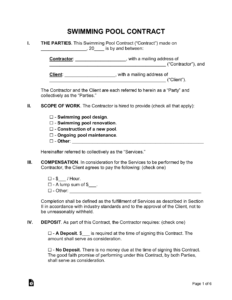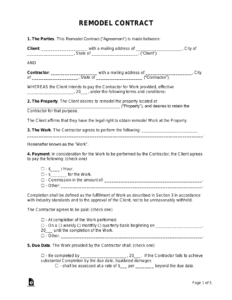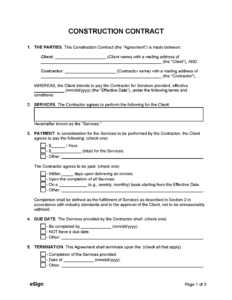Embarking on a home remodeling project is an exciting endeavor. You dream of updated kitchens, luxurious bathrooms, or that perfect backyard oasis. The vision is clear, the Pinterest boards are overflowing, and the anticipation builds. However, amidst all the excitement, it’s easy to overlook one of the most crucial elements that ensures your dream project doesn’t turn into a nightmare: a solid contract. Without a clear agreement, even the best intentions can lead to misunderstandings, delays, and unexpected costs.
This is where a reliable agreement steps in to safeguard your investment and peace of mind. Having a well-defined document is not just for the contractor; it’s equally important for you, the homeowner. It lays out every expectation, every detail, and every responsibility, ensuring both parties are on the same page from start to finish. Finding a comprehensive document that covers all the bases can seem daunting, but thankfully, there are resources available to help you get started without breaking the bank.

Why You Absolutely Need a Solid Remodeling Contract (Even for Small Jobs)
Imagine this: you’ve hired a contractor, shaken hands, and work begins. A few weeks in, you realize they’re using different materials than discussed, or the project is taking much longer than anticipated, and now they’re asking for more money for tasks you thought were included. Without a written agreement, it quickly becomes a he-said-she-said situation, leaving you frustrated, out of pocket, and with an unfinished project. These scenarios are far too common when verbal agreements are the only form of understanding.
A properly executed contract acts as your project blueprint, not just for the construction, but for the entire working relationship. It meticulously outlines the scope of work, specifying every single task, material, and finish. It defines the payment schedule, so you know exactly when and how much you need to pay, tied to specific milestones or progress points. This clarity protects you from surprise invoices and ensures the contractor is compensated fairly as work progresses.
Beyond the immediate project details, a contract provides legal recourse should disputes arise. While nobody hopes for disagreements, having a formal document means there’s an agreed-upon framework for resolution. This might include clauses for arbitration or mediation, helping to resolve issues without costly court battles. It ensures both parties are accountable and that there’s a clear path forward if things go awry, offering invaluable peace of mind throughout the renovation journey.
Key Elements Your Contract Should Include
When you’re looking at a free home remodeling contract template, it’s vital to ensure it covers all essential aspects. These are the components that will protect you and clarify the project scope:
- Project Scope and Details: A precise description of all work to be performed, including blueprints, drawings, and specifications. Ambiguity here is your biggest enemy.
- Payment Schedule: Clear breakdown of costs, deposit requirements, progress payments tied to specific milestones, and final payment upon satisfactory completion.
- Timeline and Milestones: Start date, projected completion date, and key interim deadlines. This helps manage expectations and track progress.
- Materials and Specifications: Detailed list of materials, brand names, model numbers, colors, and quality standards to be used. Who is responsible for purchasing?
- Change Orders: A defined process for how any changes to the original plan will be requested, approved, and priced. No verbal changes allowed.
- Dispute Resolution: Procedures for resolving disagreements, such as mediation or arbitration, before resorting to litigation.
- Insurance and Waivers: Proof of the contractor’s liability insurance and workers’ compensation, along with lien waivers to protect you from subcontractors’ claims.
- Warranty Information: Details on the warranty provided for workmanship and materials, including its duration and what it covers.
Ensuring your document includes these elements is paramount. Each point serves as a safeguard, preventing potential problems and fostering a smoother remodeling process. It means less stress for you and a clearer path for your contractor, ultimately leading to a better outcome for everyone involved. A robust free home remodeling contract template is the first step towards achieving this level of comprehensive protection.
How to Effectively Use Your Free Remodeling Contract Template
Acquiring a free home remodeling contract template is an excellent start, but its true value comes from how effectively you utilize it. It’s not just a document to fill out; it’s a foundation for a successful partnership between you and your contractor. The first step is to thoroughly review the template yourself. Read every clause, every paragraph, and understand what each section means. Don’t be afraid to research any legal terminology you’re unfamiliar with. This ensures you’re fully informed before presenting it to your contractor.
Once you’re comfortable with the template, it’s time to customize it. Every remodeling project is unique, and your contract should reflect that. Add specific details about your project – the exact paint colors, fixture models, and any unique design elements. Be as granular as possible. If the template doesn’t include a specific clause you feel is important, such as a penalty for delayed completion, you can often add it, but it’s always wise to consult with a legal professional for significant additions.
Here are some best practices for utilizing your template:
- Read Through Carefully: Before doing anything else, understand every section of the template.
- Fill in All Blanks: Ensure all relevant fields are completed with accurate information; leave no stone unturned.
- Discuss with Your Contractor: Sit down with your chosen contractor and go through the entire contract together, line by line. This is crucial for mutual understanding.
- Don’t Be Afraid to Negotiate: The template is a starting point. If there are terms you or your contractor aren’t comfortable with, discuss and adjust them until both parties are satisfied.
- Sign and Date All Copies: Once agreed upon, ensure both you and your contractor sign and date all copies, and that each party retains an original.
- Consider Legal Review: For very large or complex projects, having an attorney review the final contract can provide an extra layer of security.
This collaborative approach ensures that the contract isn’t just a piece of paper, but a living document that truly reflects the agreement between both parties. It fosters transparency and trust, reducing the likelihood of future disputes and ensuring everyone knows their responsibilities. Ultimately, a template provides a strong framework, and your careful customization and discussion breathe life into it, making it a powerful tool for your project.
Embarking on a home renovation is a significant investment of time, money, and emotion. Ensuring that investment is protected through a clear, comprehensive agreement is not merely a formality; it’s a fundamental step towards a successful outcome. By taking the time to understand, customize, and discuss your remodeling contract, you lay a solid groundwork for a smooth and rewarding project. It’s about building trust and clarity before the first hammer swings.
So, as you plan your dream renovation, remember the importance of a well-defined agreement. Utilize the resources available, embrace the clarity it brings, and step forward with confidence, knowing that your vision is protected every step of the way. A thoughtful approach to your contract sets the stage for a beautifully transformed home and a stress-free experience.



